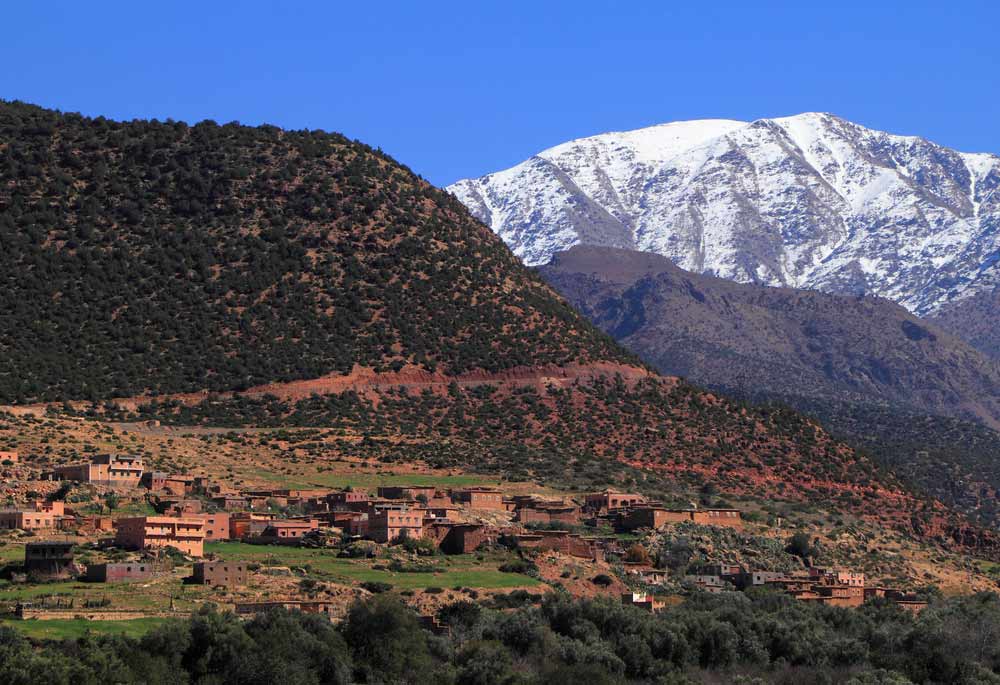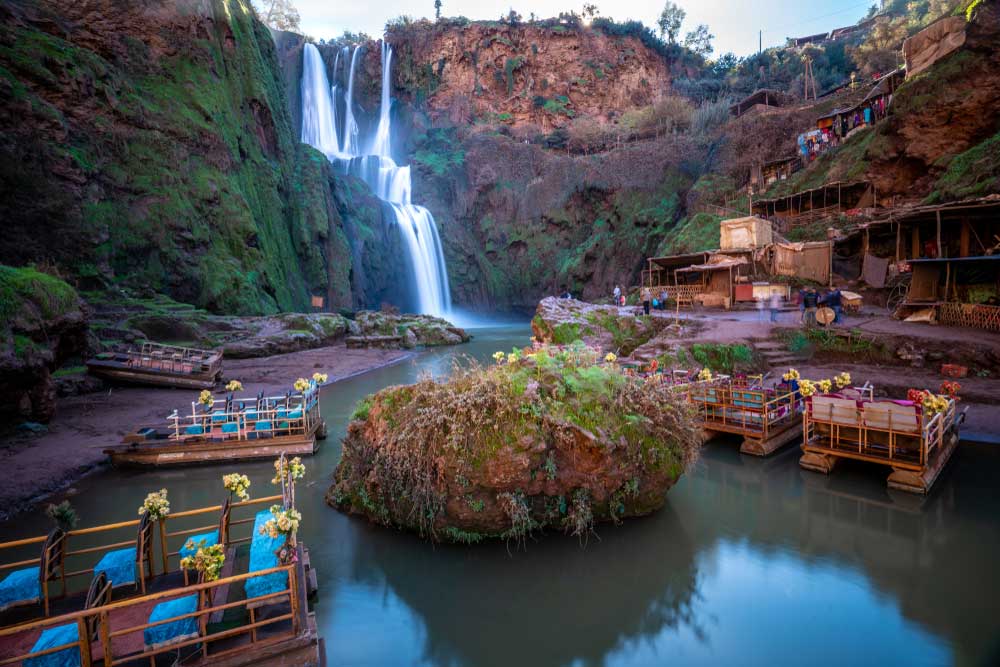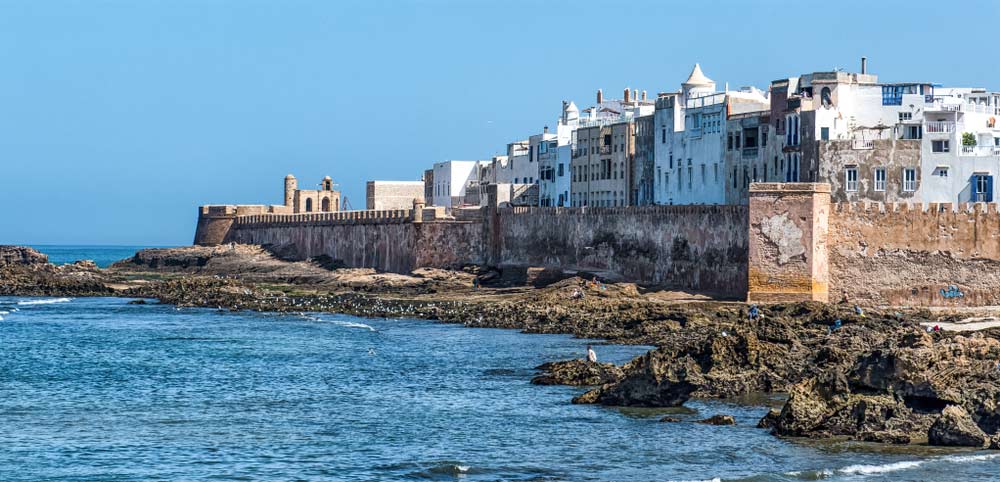Morocco is a land of incredible natural beauty. It boasts tall mountains, vast deserts, stunning waterfalls, and deep gorges. Each place offers a unique adventure and a glimpse into the rich culture of the country. This guide will help you discover Morocco’s top natural attractions.
In the north, the Atlas Mountains rise high. In the south, the Sahara Desert stretches out in golden waves. Scattered across the country are beautiful waterfalls and the Dades Gorge showcases amazing rock formations.
Exploring these wonders connects you with nature and Moroccan history. From hiking in the mountains to camel rides in the desert, there is something for everyone.
In this guide, we’ll explore the Atlas Mountains, Sahara Desert, waterfalls, and Dades Gorge. We’ll also highlight other breathtaking spots. Ready for an adventure? Let’s begin with the great Atlas Mountains.
Atlas Mountains
The Atlas Mountains are one of Morocco’s most iconic natural wonders. These towering mountains stretch across the country, offering breathtaking views and exciting adventures. Many visitors come to hike, explore, and experience the unique culture of the region. The Atlas Mountains are located in northern Morocco. They are very old and have a rich history.

The mountains extend about 2,500 kilometers through Morocco, Algeria, and Tunisia. The Atlas Mountains have been home to the Berber people for thousands of years. The mountains are known for their tall peaks, deep valleys, and diverse ecosystems.
Hiking and Trekking in the Atlas Mountains
Hiking in the Atlas Mountains is a popular activity. There are many trails and routes to choose from, catering to all skill levels.
- Popular Trails and Routes: Some well-known trails include the Toubkal Circuit, which leads to the highest peak, and the M’Goun Massif trek.
- Best Times to Visit: Spring and autumn are the best seasons for hiking, as the weather is mild and pleasant.
- Safety Tips and Guidelines: Always hike with a guide, bring plenty of water, and be prepared for changing weather conditions.
Cultural Experiences
The Atlas Mountains are not just about natural beauty; they are also rich in culture.
- Berber Villages: Visiting Berber villages offers a glimpse into traditional life. You can see their unique homes and learn about their customs.
- Local Customs and Traditions: The Berber people are known for their hospitality. You can enjoy traditional music, dance, and crafts.
- Culinary Delights: Taste delicious local dishes like tagine and couscous, made with fresh, local ingredients.
Sahara Desert
The Sahara Desert is a vast and golden landscape. It is one of the most famous deserts in the world. The Sahara covers a large part of southern Morocco. The Sahara Desert has a hot and dry climate. It has large sand dunes and rocky areas. The desert is home to many unique plants and animals.
The Sahara is the largest hot desert in the world, with extreme temperatures and scarce rainfall. Important areas include Merzouga, known for its tall sand dunes, and the Erg Chebbi, a large sea of dunes.
Desert Excursions and Activities
There are many fun things to do in the Sahara Desert. You can ride camels across the sand dunes or stay in desert camps. You can also try sandboarding and other exciting activities.
- Camel Treks: Experience the traditional way of traveling through the desert by riding a camel.
- Desert Camps: Spend a night in a Bedouin-style camp, enjoy local music, and gaze at the starry sky.
- Sandboarding and Other Activities: Slide down the sand dunes on a board or explore the desert on a 4×4 adventure.
Flora and Fauna
Even though the desert is dry, it has interesting plants and animals. Many creatures have special ways to survive in the harsh environment.
Animals like the fennec fox, desert hedgehogs, and various reptiles have adapted to the extreme conditions.
Plants such as cacti and acacia trees have deep roots and thick skins to store water and survive the heat.
Waterfalls in Morocco
Waterfalls in Morocco are spread across the country. They are found in lush, green areas. These waterfalls are popular spots for visitors who enjoy nature and tranquility. Most waterfalls are in the Atlas Mountains and surrounding areas. These waterfalls are surrounded by greenery, offering cool and serene spots to relax.

Popular Waterfalls to Visit
- Ouzoud Falls: Located in the Atlas Mountains, these are the tallest waterfalls in Morocco. The water cascades down over 100 meters. Ouzoud Falls is surrounded by olive groves and offers hiking trails and swimming spots.
- Akchour Waterfalls: Found near Chefchaouen, these falls are surrounded by beautiful hiking trails and natural pools. The area is perfect for a day trip, with clear waters and scenic views.
- Imi N’Ifri Natural Bridge: This unique waterfall flows under a natural rock bridge near the town of Demnate. The bridge creates a picturesque setting with water flowing underneath.
- Setti Fatma Waterfalls: Located in the Ourika Valley, these waterfalls are a series of seven cascades that are a popular day trip from Marrakech. Each cascade is reachable by hiking, and the area is dotted with small cafes and resting spots.
- Ourika Waterfalls: Also in the Ourika Valley, these falls are known for their beautiful surroundings and easy access from Marrakech. The hike to the waterfalls passes through traditional Berber villages.
Best Practices for Visiting Waterfalls
When visiting these waterfalls, it’s important to stay safe. Follow signs and guidelines. Respect the environment and keep it clean. Swimming can be fun, but always be careful.
- Safety Tips: Wear appropriate footwear for hiking, stay on marked paths, and be cautious around slippery rocks.
- Environmental Conservation: Do not litter, respect local wildlife, and avoid disturbing the natural surroundings.
- Enjoying the Waterfalls: Bring a picnic, swim in designated areas, and take lots of photos to remember your visit.
Dades Gorge
Dades gorge is known for its steep cliffs and unique rock formations. It offers stunning views and exciting adventures. Dades Gorge is located between the Atlas Mountains and the Jbel Saghro range. The gorge was formed by the Dades River, which carved out the deep, narrow valley over millions of years. The area is famous for its striking red and orange rock walls.
The Dades River created the gorge by eroding the rock over time, forming steep cliffs and narrow canyons. The region has been inhabited for centuries, with ancient kasbahs (fortresses) dotting the landscape.
Exploring Dades Gorge
Visiting Dades Gorge is an adventure. Here are some activities you can enjoy:
Scenic Drives: Drive along the winding roads of the gorge. The “Road of a Thousand Kasbahs” offers amazing views and photo opportunities.
- The road has many twists and turns, making it an exciting drive.
- There are several viewpoints where you can stop and take in the scenery.
Hiking Trails: There are many trails to explore. You can hike along the river or climb up to get panoramic views of the valley.
- Popular trails include the “Monkey Fingers” hike, named for the unique rock formations.
- Guided hikes are available for those who want to learn more about the geology and history of the area.
Photography Spots: The gorge has many stunning spots for photography. The rock formations, especially the “Monkey Fingers,” are a must-see.
- The contrast of the red rocks against the blue sky makes for beautiful pictures.
- Sunrise and sunset are the best times for capturing the gorge in the best light.
Nearby Attractions
Dades Gorge is not the only attraction in the area. Here are some nearby places you can visit:
Todra Gorge: Just a short drive away, Todra Gorge is another impressive canyon with tall, narrow cliffs. It’s a popular spot for rock climbing and hiking.
- The gorge is narrower than Dades, with cliffs that can be up to 300 meters high.
- There are easy walking paths along the river, making it accessible for all fitness levels.
Rose Valley: This valley is famous for its rose fields and the annual Rose Festival in May.
- The roses are used to make rose water and other products.
- During the festival, there are parades, music, and dancing.
Local Accommodations: There are many charming guesthouses and hotels in the area. Staying in one of these places allows you to enjoy the local hospitality and stunning views.
- Many accommodations offer traditional Moroccan meals.
- Some guesthouses are located in restored kasbahs, providing a unique experience.
Other Notable Natural Wonders in Morocco
Morocco has many other natural wonders beyond its famous mountains, deserts, waterfalls, and gorges. These places are also worth exploring for their beauty and unique features. Let’s learn more about them.
The Rif Mountains
The Rif Mountains are located in northern Morocco. They are known for their lush greenery and beautiful landscapes.
The Rif Mountains have dense forests, rolling hills, and fertile valleys. They are different from the dry Atlas Mountains.
There are many trails for hiking. One popular trail is the hike to Jbel Tidirhine, the highest peak in the Rif.
- Trails offer stunning views of the Mediterranean Sea.
- Hiking routes pass through small, picturesque villages.
The Anti-Atlas Mountains
The Anti-Atlas Mountains are in the southern part of Morocco. They are less visited but equally stunning. These mountains are older than the High Atlas and have unique rock formations, including volcanic rocks and mineral deposits. You can explore ancient Berber villages, hike through scenic valleys, and discover hidden oases.
- The Tafrout region is famous for its unusual rock formations, like the painted rocks.
- Hiking and rock climbing are popular activities in this area.
Morocco’s Coastal Beauty
Morocco’s coastlines along the Atlantic Ocean and the Mediterranean Sea are breathtaking.

Atlantic Coast: The Atlantic Coast has long sandy beaches, perfect for surfing and relaxing. Popular spots include Agadir and Essaouira.
- Agadir is known for its wide beaches and modern resorts.
- Essaouira is a charming old town and is a UNESCO World Heritage site.
Mediterranean Coast: The Mediterranean Coast offers rocky cliffs and clear blue waters. Places like Tangier and Al Hoceima are great for swimming and diving.
- Tangier is a vibrant city with a rich history and cultural heritage.
- Al Hoceima is known for its beautiful beaches and national park.
Coastal Parks and Reserves: There are many protected areas along the coast. These parks are home to diverse wildlife and beautiful landscapes.
- The Souss-Massa National Park is a haven for birdwatchers.
- The Al Hoceima National Park offers stunning marine biodiversity.
Conclusion
Morocco is full of amazing natural sites. From tall mountains to vast deserts, stunning waterfalls, and dramatic gorges, there is something for everyone.When visiting these places, always respect the environment and local culture. Stay safe and enjoy the adventure. Encouragement to Explore Morocco’s Diverse Landscapes: Morocco’s natural wonders are waiting to be explored. Plan your trip and experience the beauty and adventure of this incredible country.
